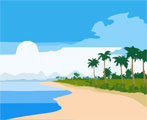  Fun Beach Facts for Kids Fun Beach Facts for Kids
Check out our fun beach facts for kids and enjoy learning a variety of interesting information about beaches. Learn about how beaches form, what is sand made of, how does wind waves and sediment size affect the shape and slope of a beach, how tall is the tallest sandcastle ever made. Read on to find out the answers to these questions about beaches. | | |
Beaches are landforms located along the shoreline of water bodies such as an ocean, sea, lake or river. They are made up of loose rock particles of materials such as sand, gravel, shingle, pebbles or cobblestones or sometimes shells.
Most beaches are found on the coast, where wave action, currents, tides and seawater rises continuously rework and shape the sediment. As a result, beaches are usually regarded as dynamic, natural phenomenon.
Depending on the type of sediment that makes up the sand, beaches can come in many different colors such as: white, gray, gold-yellow, brown, red and black.
Steep beaches have a strong wave backwash that pulls material down the beach slowly making the slope gentler. Waves on beaches that have a gentle slope run up the beach powerfully, before falling back gently, therefore depositing material at the top, which slowly makes the beach steeper.
A beach berm is a long narrow sand wedge that resembles a terrace of land, it has a steep slope facing the ocean and a gentle slope towards the land, it is an indication that the beach has been gaining sand deposits.
A beach that remains undisturbed by modern human influences (such as nearby houses, resorts, shops, camps or hotels) is often called a wild beach.
Beaches became popular as tourist attractions during the 18th century. Today, beachside towns and beach resort areas are a magnet for tourist who come to sunbathe, swim, stroll the beach, build sandcastles, surf and bodyboard.
Fraser Island off the coast of Queensland, Australia, is the largest sand island in the world covering around 163,000 ha and it has a beach 65 km (40 mi) long.
A beach is not an ideal place for most animals to live due to its constantly changing environment. Crabs and insects live in the sands while sea turtles bury their eggs on sandy beaches. According to the Guinness World Records, the tallest sandcastle ever made was constructed in Connecticut, USA, in May 2011. It was 11.53 m (37 ft 10 in) tall.
|

|
|